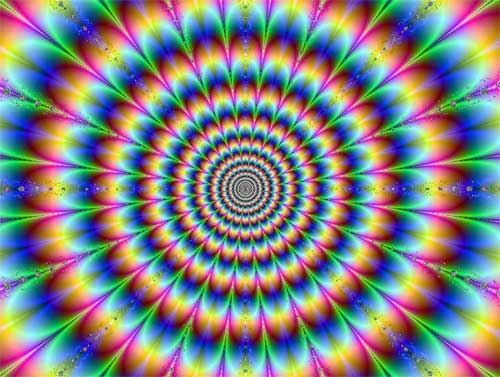The high of cannabis

For centuries, people have been using marijuana not only as a medicinal plant but also, and above all, as a stimulant, all over the world. Cannabis is one of the most popular drugs and stimulants of all. This is undoubtedly due to the very special, complex and interesting high it produces when consumed and at the same time to the low toxicity of cannabis.
Delta-9-tetrahydrocannabinol (THC) is the main active ingredient in marijuana, responsible for many of the known effects. THC rapidly enters the bloodstream via the lungs when smoked and vaporised, and is carried throughout the body, including the brain. THC binds to specific sites called cannabinoid receptors (CBRs) on the surface of nerve cells. The CBRs are part of a large communication network in the body known as the endocannabinoid system. It plays a crucial role in normal brain development and function. In fact, the THC effects are similar to those of naturally occurring substances in the brain (and body) called endocannabinoids. So when marijuana is smoked, the THC artificially stimulates the CBRs. The stimulation of the receptors in relevant areas of the brain eventually leads to the high. These receptors have been found in high density in areas of the brain involved in the sensation of pleasure, memory, thinking, concentration, movement, coordination, sensory perception and time. The "endogenous THC" (neurotransmitter) is called anandamide, a derivative of arachidonic acid, a fatty acid in cell membranes. The term ananadamide comes partly from the Indian Sankskrit "ananda" and means bliss.
The endocannabinoid system has a broad effect on the entire body and mind. Cannabis contains a large amount of the specific compounds that influence the endocannabinoid system, in varying proportions. Therefore, cannabis effects are very diverse and sometimes differ quite significantly depending on the strain and dosage of cannabis taken. Users often test different strains and dosages first to find their desired effect.
In animal experiments, ananamides triggered the entire spectrum of effects that we also know from THC. Anandamides influence movement and coordination, emotions and memory functions. Anandamides make us forget pain or overlook trivialities and put on rose-coloured glasses. They make us sociable and peaceful, but also tired and meditative. Every time we feel good, our brains take an anandamide joint, so to speak. Nerve cells with THC-anandamide receptors are found mainly in the cerebellum and basal ganglia, where movement and fine motor skills are coordinated. THC-anandamide receptors are also found in the hippocampus (part of the emotional centre) and the anterior cerebral cortex (site of consciousness and memory).
The well-known cannabis effects such as euphoria and dream-like states are explained by the effect of THC in these brain areas. However, the brain stem, which controls vital bodily functions such as breathing, contains no or hardly any receptors for THC-anandamide. This explains why THC, in contrast to opiates, has no influence on basic life-sustaining functions. This is the reason why even extremely high cannabis consumption has never led to death, unlike alcohol or opiates. THC is one of the most "non-toxic" psychoactive substances of all. Certain other cannabinoids such as CBD also play an important role in the development of psychoactive effects.
Marijuana affects each person differently. This depends, among other things, on the personal circumstances, physical conditions, the current framework conditions, one's own mental attitude, the consumption habits and the variety (quality) that is consumed. Smoked or vaporised cannabis can be felt within seconds of inhalation. The peak effect lasts about 15-30 minutes, followed by a steep decline in noticeable effects. The cannabis effects usually last between 2 and 4 hours, but this can vary. When marijuana is eaten, nothing is noticeable at first and it takes some time. After about 30-60 minutes, the effect begins. This can be very abrupt and strong depending on the dosage and last for 4-6 hours.
A marijuana high usually lasts two or three hours, during which a wide range of effects can occur, varying in intensity and quality. The different strains contain subtle differences in cannabinoid composition and many users develop preferences for certain strains. By and large, sativa is considered a stimulant and indica a sedative. There are many hybrids of the two that have different ratios. While many psychoactive substances are categorised as either stimulant, sedative or hallucinogenic, marijuana can exhibit all of these properties.
Cannabis has effects on both the body (physiological) and the mind (psychoactive). The physiological effects can be, for example, increased heart rate, redness of the eyes, lowering of intraocular pressure and muscle relaxation.

Intensification of perception
The most obvious effect is the intensification of sensations and perceptions. Colours can be more intense, scenes have more depth, basic patterns and relationships can become clearer, music is heard more dimensionally. Visual stimuli in particular are intensified, but so are all other stimuli. Music and sound are perceived more clearly and accurately as if there were less distance between the source and the listener. The use of cannabis can increase focus and concentration, making a person more aware of moods, sensations and experiences. There can be a deep sense of understanding of certain contexts, as if one has found the answer to many things. New ideas emerge. It makes sense to write them down.
Skin receptors are also affected. Heat, cold and pressure receptors become more sensitive. The consumption of cannabis leads to an improved awareness of so-called proprioceptive stimuli, i.e. one's own sensation, whereby, for example, unconscious muscle tension is perceived more readily. These effects vary, of course, as described above. Sometimes individual effects can be more prominent, sometimes a combination of all or different effects. The direction of the effects can often be manipulated by music or images. However, these factors only have an influence on perception if the person allows themselves to be affected.
The consumer himself is the most important factor here. Many focus mainly on visual stimuli when they are high. People first "learn" to perceive experiences in a different way when they start using cannabis and play with different music, demands, attention and images. This can make people aware of perceptual changes.
Time distortion
In addition to enhancing the senses, another immediate effect of marijuana is the change in the perception of time: events seem to take longer or there is the feeling that an hour has passed and in reality it was only 25 minutes. This does not create an impression of speed, it is rather as if one's own available time spreads out. There are similar effects in normal experience. In a boring conversation, time seems to pass much more slowly. Under the influence of marijuana, more information is perceived within the same time and usually more thoughts are produced, which is probably the background for the altered perception of time. Psychological contents and processes of consciousness that are not linked in our thinking to the experience of time and the idea of time, such as daydreams or fantasies, are promoted and stimulated under the influence of cannabis. The perception of time therefore recedes into the background.
Creativity
Many cannabis strains inspire creativity or can even cause downright bursts of creativity. Feelings of realisation, revelation and drive can also occur. The insights from the high, often include a deeper understanding of certain things and allow a new view. This can lead to fits of laughter or complex realisations. The personal view of one's own situation is generally broadened and thus more balanced.
Unlike alcohol intoxication, people who feel the effects of cannabis are aware of the momentary effects and tend to shape their behaviour accordingly. Many users see great potential in cannabis to increase creativity. Marijuana increases alpha wave activity in the brain, which increases blood flow to the right (brain) hemisphere, the very part of the brain responsible for non-linear and holistic thinking.
Change of awareness
Consumers can often notice a slight euphoria, happiness or satisfaction in consumption. Many banal things suddenly seem more interesting, more alive and richer in details. Problems then often seem more manageable. For some, thinking becomes more foggy, less clear or focused. Some people become more alert or self-conscious. Some become quieter while other consumers become more sociable and spontaneous. The variety consumed has a decisive influence. Due to the mind-expanding properties of marijuana, it is even revered as a sacred plant in some religions. The mental and emotional effects of cannabis are as varied as the users themselves and build around them in some ways. Especially for experienced marijuana users, higher doses can have a significantly mind-expanding effect.

Relaxation
On a physical level, marijuana helps relax muscles and reduce cramps. Cannabis is often used by adults after work to relax, unwind and wind down. Many avoid using it during the day because it makes them tired and sleepy. However, there are also a lot of consumers who use it to be balanced and active during the day as well. Many varieties produce a distinct feeling of inner peace and balance and help to reduce stress.
SEX
Many people have experienced that sex is subjectively better under the influence of marijuana. It is considered a mild aphrodisiac that increases desire and lowers inhibitions. It allows further imaginative approaches to be explored and time-linked thought processes to be pushed into the background.
Short-term influence on short-term memory
The consumption of cannabis temporarily impairs short-term memory. During a sentence, one forgets what one actually wanted to say, one loses the thread more easily. However, this only lasts for the duration of the effect.
undesirable side effects
Beginners or users who use marijuana infrequently or have a history of marijuana use may also experience undesirable effects. They feel like they are made of stone, develop paranoid thoughts or panic about the perceived mental or physical changes.
Pleasure and medicinal effect
In terms of a holistic understanding of health and the human being, the enjoyment factors that cannabis consumers value so much are related to the medicinal potential. In the end, joy of life and enjoyment cannot be separated from purely physical health. It is precisely the mentally emotional effects of marijuana that in many cases also bring about and favour the positive physical effects; the relaxation effect is just one example of this.
This text is not intended to encourage people to use drugs or to violate existing laws. It is only intended for people who are allowed to use cannabis in their country or who have a medical exemption for cannabis. Please check for yourself what the laws are in your country. We cannot take any responsibility for this. The information given is only our personal view and opinion.






